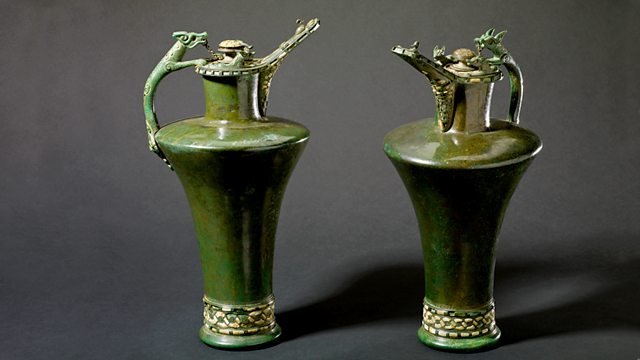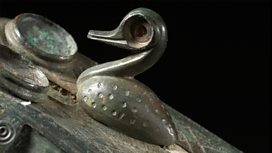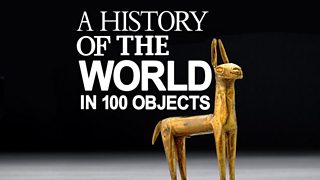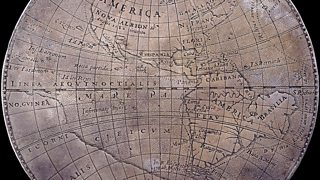Basse Yutz Flagons
A history of the world told through objects at the British Museum. Neil MacGregor on what was happening in Northern Europe two 2,500 years ago - some drinking it seems!
Neil MacGregor's history of the world recounted through objects at the British Museum arrives in Northern Europe two and a half thousand years ago.
Neil explores the early world of the Celts through two bronze drinking flagons, considered to be the most important and earliest examples of Celtic art. The writer Jonathan Meades and one of the world's leading experts on this period, Barry Cunliffe, help describe the Celts, dissect the stereotypes and consider their celebrated love of drink.
Last on
![]()
Discover more programmes from A History of the World in 100 Objects about food and farming
About this object
Location: Lorraine, France
Culture: Ancient Greece
Period: About 450 BC
Material: Metal
��
These two flagons are exquisite examples of early Celtic art. They probably came from a burial of an important person and would have been used to pour wine, beer or mead at feasts. The flagons were expensive luxuries and they contain pieces of red coral - now faded to white - traded from the Mediterranean. When wine was poured it would flow under the duck just behind the spout, giving the duck the appearance that it was swimming.
Who were the Celts?
The Celts had no writing and are known to us through Greek and Roman sources. They were a diverse collection of people who probably spoke similar languages and were not unified under a single leader. They also made and exchanged similar items characterised by the swirly, interlaced designs and stylised animals known as Celtic art. In the 1800s the notion of a shared Celtic past was crucial in shaping western European identities. 'Celtic' languages are still spoken in Wales, Ireland and Scotland
Did you know?
- European men only started wearing trousers in about 1200 BC, before then they only wore skirts.
Chasing the Duck
By JD Hill, Lead curator, A History of the World, British Museum
��
Where do you start to look when you first see objects like these?
They are covered in decoration and detail that grabs the eyes, but it is so difficult to focus on any of the detail. I am sure that is what their makers intended.
If you were a guest at a feast 2,500 years ago and first saw these flagons across the room, what would first strike you is their colour and unique, exotic shapes. Then, if you were sober enough, as one of them was carried close to you to fill your cup, you might focus on one or two parts of the very complex decoration. But it is only after you have seen them close up on many different occasions that you really get a sense of all the different parts of the decoration across their bodies.
For me if there is one piece of decoration on the flagons that first catches the eye, it is the little duck sitting on the ends of the spout. I suspect for many Iron Age drinkers the duck would also be the focus of attention, as when you held your cup to be filled, the little duck almost appears to be swimming on the alcohol pouring out of the spout.
Ducks and other water birds were a common decoration on many different metal objects made in Europe in the Late Bronze Age and Iron Age
Having studied the religion of Iron Age Europe, it is clear that ducks and other water birds must have had an important place in these peoples’ myths and religions. Rivers, lakes and bogs across Iron Age Europe were important places to make offerings of metal objects to the gods or ancestors.
Perhaps, rivers and lakes were seen as doorways to another world. If so the birds that swam and lived on these rivers and lakes may have been seen as very special creatures that could cross this magical boundary – even more so if they flew away to unknown places for part of the year when they migrated.
So this little duck – which originally had red beads of coral for its eyes – was probably not just to amuse the drinker as it swam in the beer, wine or mead. The original revellers would have also known about the bird’s symbolic importance – if they were not already too drunk to think straight.
Transcription
Broadcasts
- Wed 24 Feb 2010 09:45�鶹�� Radio 4 FM
- Wed 24 Feb 2010 19:45�鶹�� Radio 4
- Thu 25 Feb 2010 00:30�鶹�� Radio 4
- Wed 26 Aug 2020 13:45�鶹�� Radio 4
Featured in...
![]()
Food and Farming—A History of the World in 100 Objects
A History of the World in 100 objects - Food and farming
Podcast
-
![]()
A History of the World in 100 Objects
Director of the British Museum, Neil MacGregor, retells humanity's history through objects





